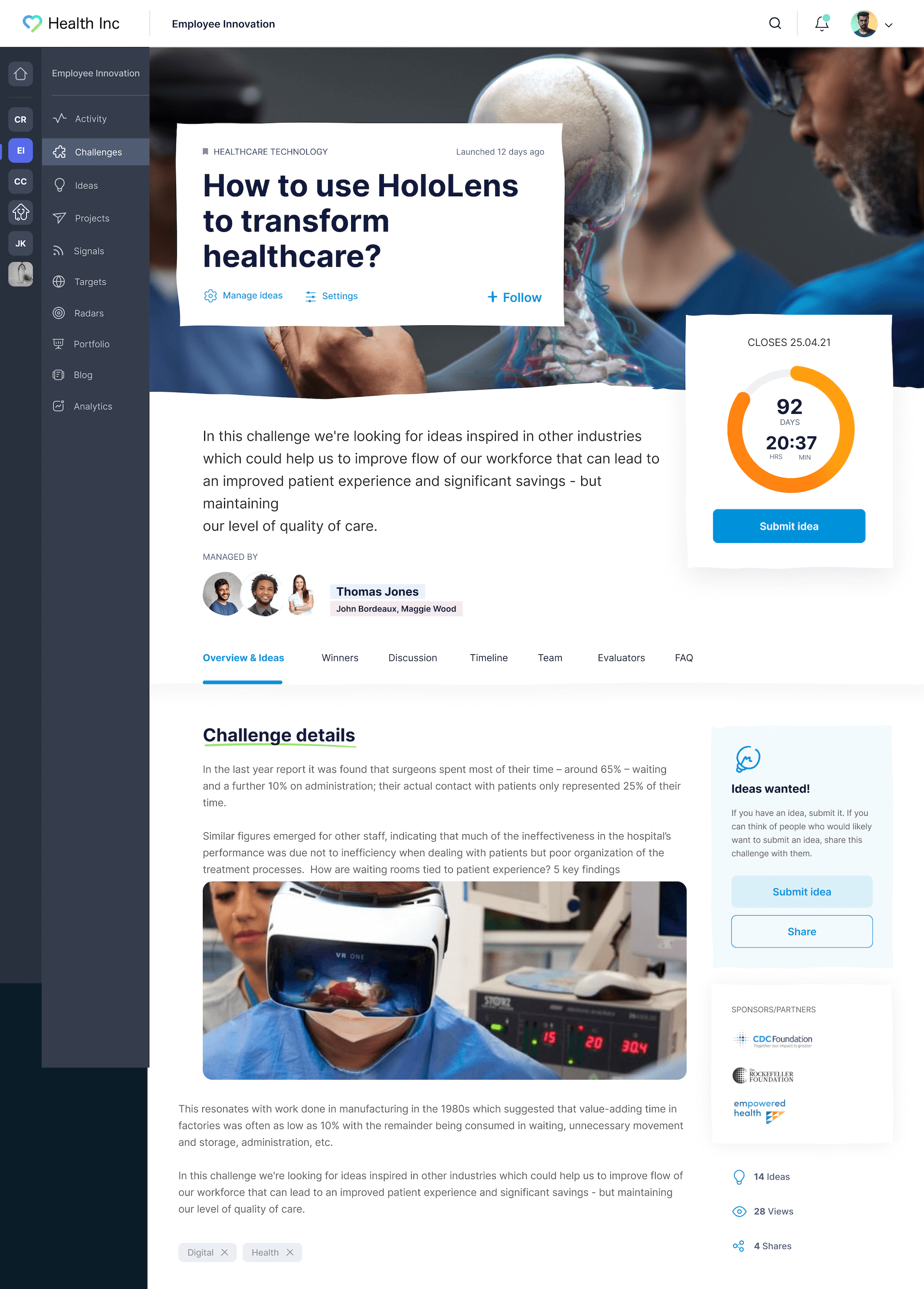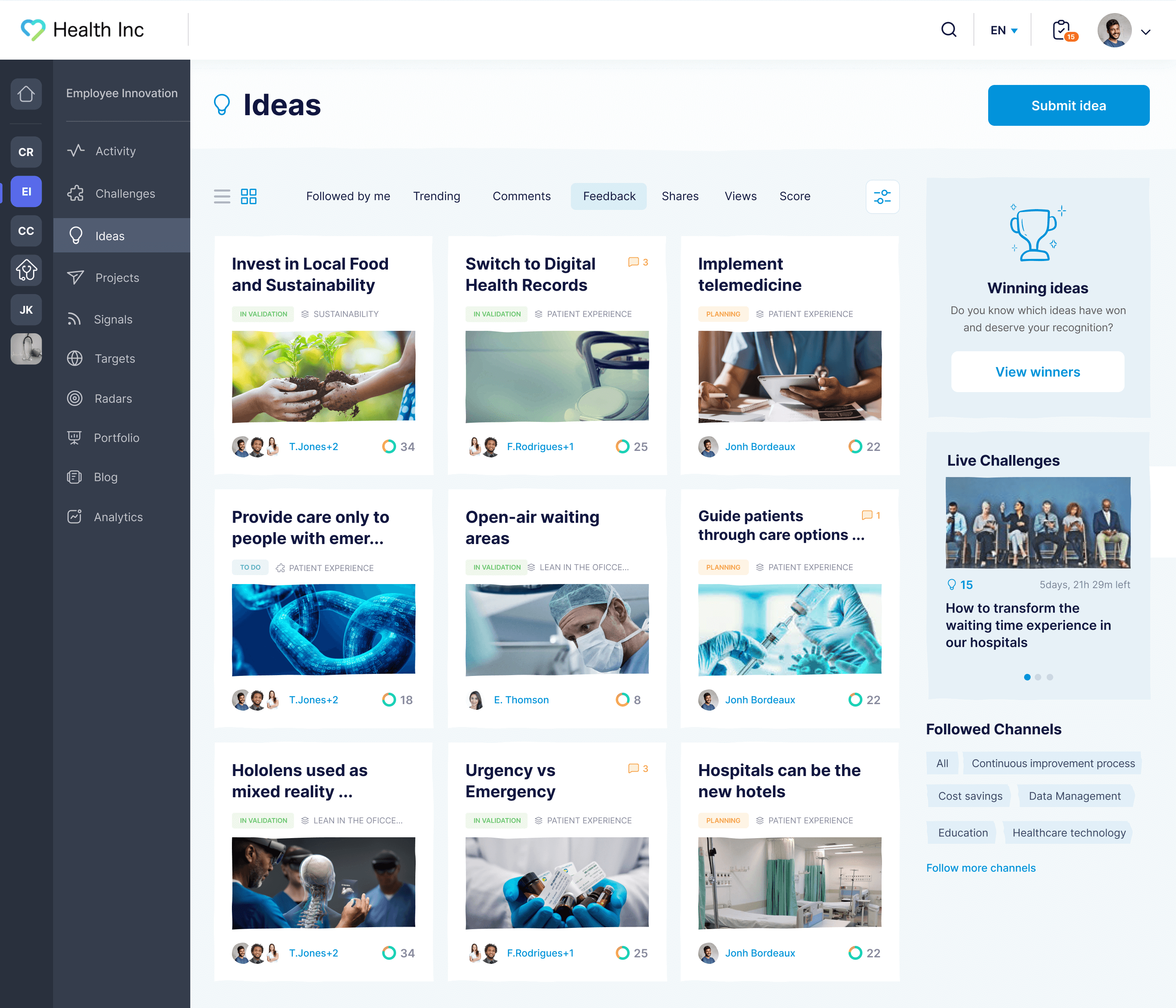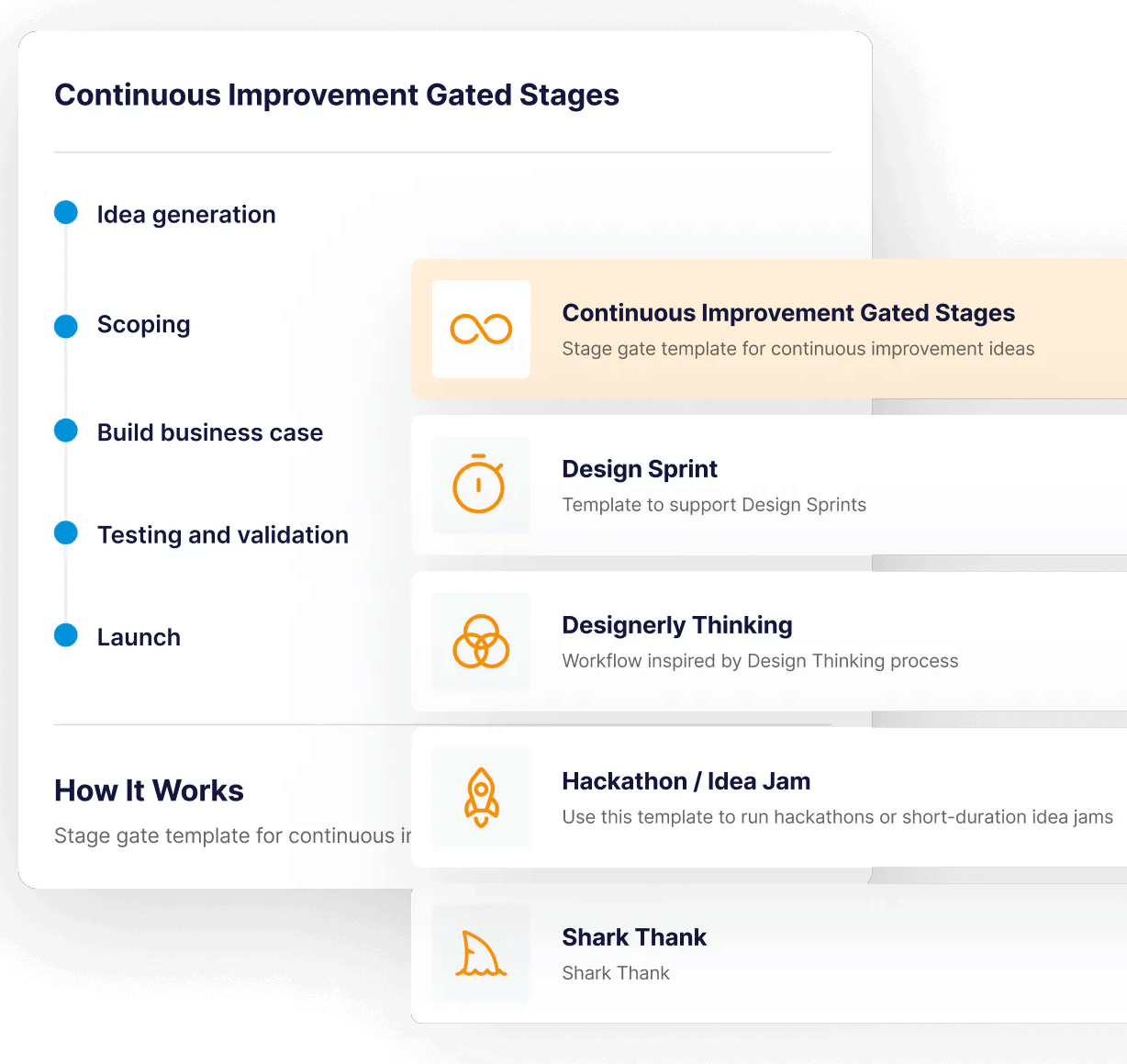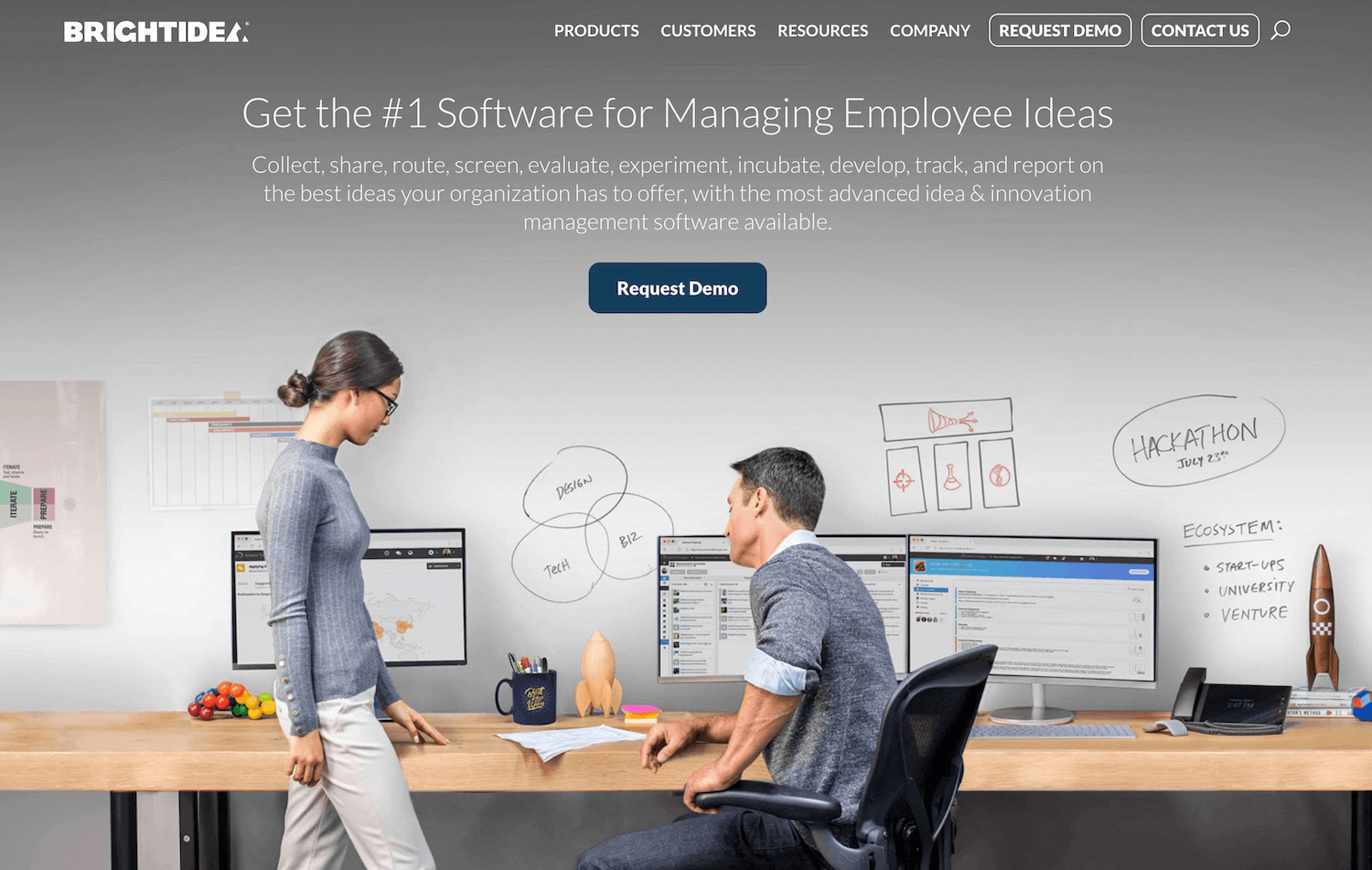Innovation platforms should help organizations gather and nurture high-quality ideas into deployable solutions. Organizations frequently adopt these platforms in an effort to establish a culture of innovation among employees.
In our decade-plus experience helping organizations set up innovation processes, we’ve learned that there are four factors to consider when choosing an innovation platform:
Features to focus ideation on specific priorities: Many platforms support idea collection with an open call for any and all ideas. Although this strategy can uncover unexpected insights, it mainly results in random ideas unrelated to the organization’s priorities. Instead, an effective innovation platform should align all users’ ideation efforts with the organization’s priorities.
Features to improve ideas using the collective expertise of the entire workforce: First-draft ideas are often flawed and incomplete and must be improved before evaluation. So, an effective innovation platform should harness the collective expertise of all employees (and outside experts) to improve ideas.
Workflows that structure evaluation and validation tasks: We’ve noticed that organizations usually struggle to develop ideas into actual solutions because they struggle to implement promising ideas and realize their benefits. Innovation software should offer workflows that guide users through evaluation and validation steps; users shouldn’t be left alone to determine the next steps.
Educational materials that get people to participate: Many employees don’t participate in innovation because they misunderstand what it is. They believe innovation is about ground-breaking technological breakthroughs when, in fact, it’s mainly small improvements to existing solutions. This causes them to think their input isn’t needed. So, the right platform should provide training materials that debunk myths preventing employees from participating.
In this article, we discuss five top-rated innovation platforms. We begin by covering how our innovation platform, InnovationCast, meets the four criteria listed above. Then, we review additional options such as Qmarkets, Brightidea, Wazoku, and HYPE Innovation.
InnovationCast has implemented innovation programs for Visa, DHL, Vodafone, and others in under four weeks. Book a 25-minute demo to learn how we can do the same for you.
1. InnovationCast
An Innovation Platform That Supports Ideas from Collection to Implementation and Impact Tracking

As we shared in our founding story, we created InnovationCast because existing innovation providers didn’t meet all four criteria mentioned above.
Open innovation platforms often promote idea collection by asking users to submit ideas on any topic, resulting in random ideas. Others fail to structure post-collection workflows, leaving organizations unsure of how to proceed with ideas.
We designed InnovationCast to source high-quality ideas aligned with innovation strategy, guide users through post-collection steps, and establish innovation programs with strong participation in under four weeks.
Features to Focus Ideation on Specific Priorities
Organizations can collect ideas in two ways:
Innovation Challenges — A top-down approach where management informs employees of current priorities and invites them to submit relevant ideas.
Category-based “Always On” — A bottom-up approach that enables users to alert management to new opportunities and threats.
Innovation Challenges Provide Context on the Organization’s Priorities
Innovation Challenges are time-constrained calls for users to submit ideas on specific topics.
Innovation managers, department managers, or any stakeholder can create open innovation challenges to source ideas aligned with their priorities. InnovationCast automatically notifies users to participate.
This approach enables organizations to focus the creative brainpower of all employees and outside users on their key priorities.

What sets InnovationCast apart is that we provide users with templates, case studies, and examples to help them create effective challenges. These resources are based on our decade of experience as innovation consultants, highlighting what works and what doesn’t. We don’t leave challenge managers to figure this out alone.
Additionally, when creating a challenge, InnovationCast analyzes the user’s inputs and suggests improvements. This may include things like focusing on a specific point, making sure you have a quote from a sponsor, or outlining the evaluation criteria.
Then, when users and other problem solvers respond, InnovationCast analyzes their inputs and recommends ways they can improve their ideas. This leaves challenge managers with higher-quality ideas.
Finally, InnovationCast can detect when a user is about to submit an idea similar to one already submitted. It will then suggest the user co-create with the original author to improve their idea. This way, challenge managers don’t have to filter through duplicate ideas.

Read more: 6 Innovation Challenge Software (2024 Comparison)
Uncover New Insights with Our Category-Based “Always On” Feature
That said, open calls for ideas still play a role in an effective innovation program because they allow users to notify top management about new opportunities and threats. This is why we added the category-based “Always On” feature to InnovationCast.
Unlike traditional open calls, “Always On” requires users to bucket their ideas into topics defined by top management, ensuring that all ideas align with broader areas of interest.
For example, the screenshot below shows a hospital asking users to sort their ideas into healthcare technology, infection control, patient experience, and sustainable healthcare.

Read more: How to Implement an Effective Idea Generation Process in Your Organization
Features to Improve Ideas with the Collective Expertise of the Entire Workforce
Even with the features mentioned above, it’s rare for someone to submit a perfect idea from the start. There are usually aspects the author didn’t consider or information they forgot to include, which is normal. The first version of any idea needs exploration and iteration.
To further improve idea quality, innovation managers can display ideas on the InnovationCast activity feed, making them visible to all users when they log in.

InnovationCast encourages users to analyze the details of these ideas and say whether they believe they are “Good,” “Not so good,” or “Undecided.”

InnovationCast requires users to provide feedback on how to improve ideas.
This allows ideas to be enhanced with the expertise of employees across the organization. Teams from engineering, finance, marketing, IT, and other departments contribute to refining ideas, leaving evaluators with more complete concepts, not first drafts.
Workflows That Structure Evaluation & Validation Tasks
In our decade of innovation consulting, we often saw organizations struggle with what to do after collecting high-quality ideas. They’d select promising ideas but lacked a structured approach for moving forward.
To solve this, we designed InnovationCast with detailed workflows that guide users through the tasks they must complete to evaluate, validate, and prioritize ideas. This approach has helped companies like DHL increase implemented ideas by 14% in just four weeks.
Workflows That Help Teams Navigate the Steps After Idea Collection
InnovationCast offers idea-specific workflows that structure the work needed after idea collection.
What sets us apart from other innovation platforms is that users can access different workflows for various types of ideas — they aren’t limited to a single, cookie-cutter workflow. Product ideas, business model ideas, supply chain ideas, and technological ideas each have their own workflows.
These workflows include different screening questions, evaluation criteria, business scorecards, and validation tasks. Additionally, users can configure workflow steps to fit their organization’s processes by adding, removing, or dragging and dropping a few design blocks.
Our workflows are built on over 10 years of consulting experience and methodologies like Lean Startup, Discovery-driven Planning, Customer Development, and Jobs to Be Done.
Here’s an example of a continuous improvement workflow:

Our workflows usually start by showing idea evaluators what evaluation model and criteria to use based on the type of idea they are evaluating. With this guidance, they can identify high-potential ideas while also determining which ideas to table.
Then, for high-risk, high-uncertainty ideas, InnovationCast may suggest assembling validation teams to run experiments and test ideas before implementation.

For instance, if the organization is uncertain about its capability to develop the product, we may recommend creating a prototype or a Spike first. If customer demand is unclear, we could suggest setting up a website with a fake brand name and running ads to measure how many people check out.
Finally, our workflows include KPIs that validation teams should measure based on the type of idea, along with minimum success criteria to help them determine whether to proceed with launching the idea.
Read more: 6 Steps to an Effective Idea Management Process
Educational Materials That Get People to Participate
Innovation managers often struggle to get people to participate in innovation efforts, which is why many innovation programs fail.
We’ve learned that the main reason for this is that employees have a fundamental misunderstanding of innovation. They think innovation is for scientists and engineers working on revolutionary ideas, and the organization doesn’t need their input.
Employees don’t realize that small, continuous improvements to live products, services, and processes are the most common form of innovation and that their ideas can significantly improve the organization’s bottom line.
So, we designed InnovationCast with educational materials to address those concerns and myths. Our system automatically delivers these materials to users via email in manageable increments. This helps organizations drive high participation in a short amount of time.
This is a shortcoming of many innovation tools. They fail to sufficiently debunk the myth that innovation isn't for everyone, resulting in low participation levels.
To boost participation rates, InnovationCast sends users emails when:
They have been inactive for a certain period of time.
New challenges are released.
Their input is needed to evaluate or validate an idea.
They have submitted an idea, updating them on its status (whether it is being evaluated, validated, or launched).
Read more: How to Encourage Innovation in the Workplace
Additional Tools to Help Establish an Effective Innovation Program
Signals & Scouting
To help organizations stay current on industry and competitor news, we added a trend management feature called Signals & Scouting to InnovationCast.
Signals & Scouting encourages users across the organization to share news about important opportunities or threats with colleagues and managers. This improves competitiveness, as everyone stays on top of competitor news, emerging technologies, new businesses, and industry trends.

When users log into InnovationCast, they can see these resources and discuss whether they merit action, helping generate new ideas.
Innovation Radars
Innovation Radars complement our Signals & Scouting feature by allowing users to visualize all the submitted Signals across the organization, categorized by different business areas and importance levels. If innovation managers and stakeholders notice radars with little activity, they can encourage users to gather news in those areas.

Badges & Rewards
Users spend hours brainstorming, researching, and submitting ideas, and if they aren’t rewarded for their hard work, they may be discouraged from participating in the future.
With this in mind, we added a badges and rewards program to InnovationCast that helps organizations maintain high participation rates. Organizations can reward users when they complete tasks like responding to a challenge with a high-quality idea or improving a colleague’s idea.

Organizations can reward users with anything, including cash prizes, PTO, gift cards, or movie tickets.
What InnovationCast Clients Say
Here’s what innovation managers say about our platform:

Set up an Innovation Process Within Just Four Weeks Using InnovationCast
Companies like DHL, Vodafone, ING, Novo Nordisk, and Visa have used InnovationCast to establish innovation programs that gather high-quality ideas and turn them into shippable solutions.
Because we provide guidance (workflows, frameworks, and templates) for every part of the innovation process, it has enabled companies like DHL to increase idea submissions by 67% and implemented ideas by 14%.
Schedule a free demo with our team to learn more about our innovation platform.
2. Qmarkets

Qmarkets is an idea management platform built for larger organizations looking to quickly establish a culture of innovation among their workforce. Qmarkets comes with features required for organizations to manage the entire lifecycle of an idea, from idea collection to refinement, validation, and impact tracking.
During onboarding, their customer success team and innovation consultants will jump on a call with you to discuss your innovation strategy (or help establish one if needed) and tweak their software around your needs.
Features
Idea management: Innovation managers can collect and store ideas on specific topics within Qmarkets’ idea management system. Then, they can give other users access to them so everyone can co-create.
Continuous improvement: Innovation managers can source ideas on how to improve existing products, services, and processes.
Trend management: Innovation managers can encourage users to share industry and competitor news they believe everyone else inside the company should know about.
Technology scouting: Innovation managers can use Qmarkets’ collaboration tools to connect with startups, universities, incubators, and other companies to build solutions that solve complex problems.
Innovation portfolio: Innovation managers can get a 360-degree view of all the projects currently being worked on. They can see their stage (evaluation, validation, implementation) and track their impact.
3. Brightidea

Brightidea is an idea and innovation management platform that empowers organizations — including enterprise companies, startups, universities, non-profits, government organizations — to utilize their entire workforce to come up with innovative ideas that solve current problems.
When you sign up, their team joins you on a call to get deeper insight into the goals you’re looking to achieve by setting up an innovation program. Then, they tailor their challenge, co-creation, workflows, and reporting features around these considerations.
Features
Idea box: Brightidea’s idea collection feature allows users inside and outside the company to propose ways to address priorities and initiatives.
Program: Innovation managers can educate users and external partners on the innovation strategy and the types of ideas they require. Then, they can call everyone to submit relevant ideas.
Lab: This is Brightidea’s idea management dashboard. Innovation managers, stakeholders, and employees can view all ideas here, evaluate them, and run experiments to test them before sending them off to the project management office for implementation.
Transformation: This project management feature lets organizations manage innovation projects. They can give teams various tasks, assign deadlines, and allocate resources, all within a single dashboard.
Ecosystem: This is where innovation managers and stakeholders can connect with startups and enterprise companies to co-create and connect with investors and sponsors to fund innovation projects. This improves the sustainability of the innovation program.
However, it’s important to note that many reviews talk about how users require a fundamental understanding of CSS and HTML to fully customize features and utilize the platform.
4. Wazoku

Wazoku is a cloud-based innovation and idea management software. They have worked with companies like Microsoft, HSBC, Barclays, and Allianz to establish organization-wide innovation programs.
They use various features to crowdsource ideas from employees and then evaluate and validate them before implementation. Many users say that Wazoku will consult with you during onboarding to better understand your innovation goals and set up the platform around those goals.
Features
Internal innovation: This is an ecosystem of tools that allows innovation managers to gather high-quality ideas from employees and external stakeholders, incentivize them to participate with a rewards system, and use training materials to educate employees on the benefits of innovation.
Co-creation: Where employees and outside users collaborate to improve existing ideas.
Open innovation: Where innovation managers and stakeholders can access outside talent to find solutions to organizational pain points, priorities, and initiatives.
Technology scouting: Where innovation managers can discover new technologies and find startups to partner with.
Innovation networks: Innovation managers and stakeholders can utilize Wazoku’s hub of innovation teams to work together and develop the latest solutions, which are displayed at Wazoku's yearly showcase.
5. HYPE Innovation

HYPE Innovation is end-to-end innovation management software meant to help organizations of all sizes generate high-quality ideas, realize the best concepts, and bring them to life with thorough validation workflows and project management features.
HYPE’s suite of products offers strategic partnership management software and a whiteboard tool alongside their traditional open innovation platform.
Features
Strategy: HYPE’s team of consultants will help you establish an innovation strategy by identifying areas of the business you want to improve.
Ideation: HYPE offers a few ideation tools, such as always open and time-limited calls for ideas that innovation managers can use to spark creative thinking among employees.
Partnering: Innovation managers and stakeholders can use this feature to identify business and investment opportunities.
Projects: Innovation departments can manage entire validation projects within a single dashboard. HYPE has workflows that help teams determine what to do to validate ideas and project management features to launch ideas.
Get Started
You can learn more about how InnovationCast can help your organization establish a vibrant innovation program by scheduling a free demo with our team.
Related reads:

